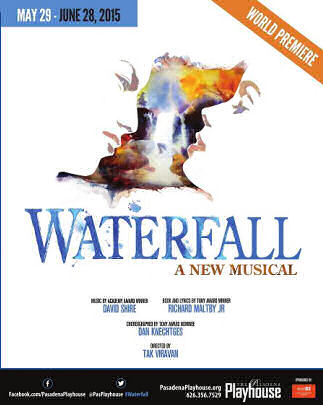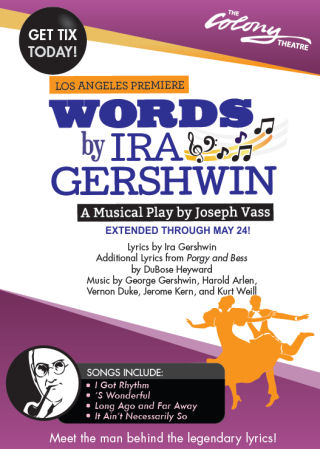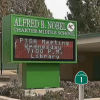
 This week marks the start of the 2015 Hollywood Fringe Festival (FB), an ambitious effort where approximately 274 shows are mounted over 19 different venues during the month of June. For the last two Fringes, we’ve only made it to one show (the musical from Good People Theatre (FB)). This year, we’ve tried to hit more Fringe shows. We’ve typically got 3 shows each Fringe weekend, and that only hits a small percentage of the shows. Our first Fringe show was to be Clybourne Park (Lounge Theatre), but alas they cancelled on Thursday. Perusing the other shows available on Saturday night, we selected Camenot: The Broadway Style Medieval Musical (Acme Theatre @ The Complex) (FB) as its replacement. The published description intrigued us: “Kings, Queens, knights, maidens, magic and music! Is it Camelot? No… it’s the nearby but far less perfect kingdom of CAMENOT, where everyone grows up on the wrong side of the trail. Join the cast of this broadway-style medieval musical on their hilarious, improvised quest for that coveted fairy tale ending!” So, after seeing Grease (The Movie) in a singalong showing as a subscriber reward at The Colony Theatre (FB), we toddled over to Hollywood to wait at Fringe Central (which wasn’t open yet), hung around at the Hudson Cafe, had dinner, and toddled down the street to The Acme Theatre at the Complex Theatres (FB) for Camenot.
This week marks the start of the 2015 Hollywood Fringe Festival (FB), an ambitious effort where approximately 274 shows are mounted over 19 different venues during the month of June. For the last two Fringes, we’ve only made it to one show (the musical from Good People Theatre (FB)). This year, we’ve tried to hit more Fringe shows. We’ve typically got 3 shows each Fringe weekend, and that only hits a small percentage of the shows. Our first Fringe show was to be Clybourne Park (Lounge Theatre), but alas they cancelled on Thursday. Perusing the other shows available on Saturday night, we selected Camenot: The Broadway Style Medieval Musical (Acme Theatre @ The Complex) (FB) as its replacement. The published description intrigued us: “Kings, Queens, knights, maidens, magic and music! Is it Camelot? No… it’s the nearby but far less perfect kingdom of CAMENOT, where everyone grows up on the wrong side of the trail. Join the cast of this broadway-style medieval musical on their hilarious, improvised quest for that coveted fairy tale ending!” So, after seeing Grease (The Movie) in a singalong showing as a subscriber reward at The Colony Theatre (FB), we toddled over to Hollywood to wait at Fringe Central (which wasn’t open yet), hung around at the Hudson Cafe, had dinner, and toddled down the street to The Acme Theatre at the Complex Theatres (FB) for Camenot.
Unlike a lot of shows we see, Camenot is not a scripted show. It is improvisation. At the beginning of the show, the men in the cast come out and asked for a medieval noun. In our case, someone shouted out “Chalace”. The ladies in the cast then come out and ask for an “adjective”; our’s was “lumpy”. As a result, our show was about “The Quest for the Lumpy Chalace”.
Now, I sincerely doubt that this is 100% improvisation. That would be difficult when you have musical accompaniment. My guess is that the improvisation team works the selected item into a rough framework of a story, with pre-defined musical pieces that are engineered to support some level of improvisation.
[Edited Interruption: Turns out, I was wrong on my doubt. The director commented (see the comments section) the following: “The show is pure improvisation. There is no preset plot structure, there are no preset characters and there is no preset music that our cast plugs lyrics into. Jonathan Green is making up the music on the spot right along with us! Like a pure free jazz ensemble, we rehearse improvising together, but don’t have any framework, other than it will be medieval in nature. ” This makes what this company does even more impressive. Coming up with music and lyrics on the fly is exceedingly difficult, especially when there is no preset arrangement between the fingers on the keyboard and the brain making the words. Now we resume….]
The fact that this was improvisation was clear; cast members standing to the side often were visibly stifling laughter at what other cast members were doing. I had no problem with that — the audience has fun when the cast has fun, and this cast was clearly enjoying what they were doing.
I’ll describe, roughly, the story we had. As just noted, I guess other stories will be similar but not the same — I could imagine a very different story if the improvised item was a “Filthy Bath”. In our story, there was a serf family — a husband (Garrett, if I recall correctly), wife, and three children — dealing with a bad drought. The husband collects some good and goes off to the man in the castle to give him anything to fix the drought. He asks the man (whose name was Cunningham) to collect the tears of the Druidia the woodland nymph and bring them back to him. Druidia, however, is pissed at Cunningham in the castle for breaking promises, and lying about the death of her true love (Thomas, the grandfather of the husband on the quest, who made the lumpy chalice). She relates the story, gets sad, cries, and the tears are collected. When the man returns to the castle, the ghost of his grandfather appears and explains the true story. The principals are brought together, and Druidia throws away the tears, which ends the drought (oh, were it that easy). The family is restored to happiness, Cunningham loses, and Druidia is happier again. Onto the basic scaffolding were overlain about 4-5 songs, all of which were enjoyable in the moment but ultimately not memorable.
All of the story above is conveyed through acting and improvisation, for the set was a basic black box with an upper level, and perhaps one or two smaller boxes on stage that provided seating. There were no props; the only other thing on the stage was the music director (Jonathan Green (FB)) at his keyboard, with a visible clock to ensure the production fit within the 45 minute allotted timeslot. As such, imagination and the art of the theatre came to the fore, and worked quite well. This is a great reminder that it is not fancy production values and perfect set realism that makes a show — it is the talent of the actor to create the set in the mind.
 The cast of the show (a significant subset of the normal show cast) — Brian Giovanni (FB), Brian Breiter (FB), Joseph Limbaugh (FB), Beth Leckbee (FB), Kimberly Lewis (FB) [who we’ve seen before in Moon Over Buffalo], & Amanda Troop (FB), under the direction of Brian Lohmann (FB) — were very talented (in the picture to the right, the men (in the order listed, L to R) are in the back row, the women (in the order listed, L to R) in the front). I was particularly impressed with the singing voices of both Leckbee and Troop — they had lovely strong and pure voices that were a delight to the ears. As I started with the ladies, I’ll note that they were also strong with the comedy. I recall the woodland scenes with Leckbee as Druidia, with the other ladies acting as animals — with Troop as a trilly-lizard. The men also were strong on the comedy side, particularly Limbaugh as the husband on the quest, and Breiter as Cunningham. It was hilarious to watch the actors trying to catch up and react as new directions were suddenly improvised (particularly when they were standing on the side — I recall quite a few scenes where you could see the actors on the side on the edge of laughter from their colleague’s improvisations). It takes a quick mind and a quick wit to pull that off; this team did it well. My guess is that this comes from the fact they regularly improv together on this show throughout the year.
The cast of the show (a significant subset of the normal show cast) — Brian Giovanni (FB), Brian Breiter (FB), Joseph Limbaugh (FB), Beth Leckbee (FB), Kimberly Lewis (FB) [who we’ve seen before in Moon Over Buffalo], & Amanda Troop (FB), under the direction of Brian Lohmann (FB) — were very talented (in the picture to the right, the men (in the order listed, L to R) are in the back row, the women (in the order listed, L to R) in the front). I was particularly impressed with the singing voices of both Leckbee and Troop — they had lovely strong and pure voices that were a delight to the ears. As I started with the ladies, I’ll note that they were also strong with the comedy. I recall the woodland scenes with Leckbee as Druidia, with the other ladies acting as animals — with Troop as a trilly-lizard. The men also were strong on the comedy side, particularly Limbaugh as the husband on the quest, and Breiter as Cunningham. It was hilarious to watch the actors trying to catch up and react as new directions were suddenly improvised (particularly when they were standing on the side — I recall quite a few scenes where you could see the actors on the side on the edge of laughter from their colleague’s improvisations). It takes a quick mind and a quick wit to pull that off; this team did it well. My guess is that this comes from the fact they regularly improv together on this show throughout the year.
One failing of the show, alas, is that they do not provide a program. I was able to piece together the cast above from the list on the HFF website and the cast page for the show. However, they do not list any technical credit. Clearly there was no set design, no sound design, no stage manager, and such. There was however a lighting design, which was simplistic but worked reasonably well to convey mood. There was also likely a costume designer, but as the actors arrived in costume (I was talking to both Kimberly Lewis and Joseph Limbaugh outside before the show), it could have just been from the actor’s closet. I’ll note they were not the realistic costumes one sees at RenFaire; rather, they were more the velour/velvety costumes that musicals such as Camelot have led us to believe were the height of fashion in medieval times. In spite of that, I did find the costumes cute; I particularly enjoyed the little touches that Beth Leckbee put on her costume.
This production would be quite at home on the RenFaire stage; I’m surprised they haven’t done it before. But I guess a RenFaire-ish improve on an intimate theatre stage but not the Faire itself balances Moonie and Broon (FB), who are regularly at Faire, but doing a single show at the Colony on June 20 (see how cleverly I worked that in :-)). We went last year and it was quite fun; this year, the Fringe Festival was booked first.
Camenot has three more shows as part of the Fringe: 6/13 at 10pm; 6/19 at 7:30 pm, and 6/27 at 4:15 pm. They also evidently do the show monthly the first Saturday of the month at Acme. Fringe tickets may be purchased from the Fringe website and are only $10; tickets during the year may be purchased through the show website (although there are no tickets listed there). Check here for Goldstar discount tickets, but be forewarned they haven’t listed any since 2014. C’mon, the show is only $10 — you can afford to pay full price! I do recommend the show — the production values may not be the greatest, but it is a fun short evening and clever improv…. plus every show is different.
One last note on this show: The tickets they used were actually advertisements for the NoHo Fringe Festival (FB), which will be October 1-25, 2015. Alas, we already have a fair number of weekends booked (yes, I do plan that far in advance), but given this is NoHo, we’ll try to squeeze in as much as we can. Thanks to Acme for bringing this to our attention.
Other Fringe Show Notes. Before the show, we had dinner over at EatThis Cafe. While there, we had a lovely discussion with Ann Starbuck (FB), the author and star of Tiananmen Annie. The show sounds interesting; we may try to fit it into our schedule; most likely it will be my wife who will succeed in doing so. Based on our discussion, I recommend you consider her show. It has gotten good writeups in the past.
 Grease Sing-a-Long at the Colony. As noted above, before the Fringe show, we went to Grease (The Movie) in a singalong showing as a subscriber reward at The Colony Theatre (FB). This is a movie that has been out for a while and there’s no real point in reviewing it. I do, however, have a few comments:
Grease Sing-a-Long at the Colony. As noted above, before the Fringe show, we went to Grease (The Movie) in a singalong showing as a subscriber reward at The Colony Theatre (FB). This is a movie that has been out for a while and there’s no real point in reviewing it. I do, however, have a few comments:
- It was interesting to contrast seeing the movie on a big screen vs. at home on TV. I was able to note the background performers much more, and to see who was singing and who wasn’t, and how the background would suddenly break out in dance.
- We guessed, while watching the show, that it was filmed at either Van Nuys HS or Venice HS. We were right about Venice. The location used for the carnival scene at the end (which turned out to be Huntington Park HS) was clearly a different school from the fictional Rydell.
- The actors look much less like believable teenagers on the big screen.
- Turnout for the performance was poor — perhaps 20 people. Surprisingly, a number had never seen the movie (such as the older couple behind us …. that kept talking)
Ob. Disclaimer: I am not a trained theatre critic; I am, however, a regular theatre audience. I’ve been attending live theatre in Los Angeles since 1972; I’ve been writing up my thoughts on theatre (and the shows I see) since 2004. I do not have theatre training (I’m a computer security specialist), but have learned a lot about theatre over my many years of attending theatre and talking to talented professionals. I pay for all my tickets unless otherwise noted. I am not compensated by anyone for doing these writeups in any way, shape, or form. I believe in telling you about the shows I see to help you form your opinion; it is up to you to determine the weight you give my writeups.
Upcoming Shows: Today brings a Men of TAS outing to see the Lancaster Jethawks, so alas there is no more theatre today. The bounty that is the Hollywood Fringe Festival (FB) continues throughout June. Next weekend brings Max and Elsa. No Music. No Children. (HFF) at Theatre Asylum (FB) and Wombat Man (HFF) at Underground Theatre (FB) on Saturday, and Marry Me a Little (HFF) by Good People Theatre (FB) at the Lillian Theatre (FB) on Sunday. The craziness continues into the third weekend of June, with the Nigerian Spam Scam Scam (HFF) at Theatre Asylum (FB) and Merely Players (HFF) at the Lounge Theatre (FB) on Saturday, and Uncle Impossible’s Funtime Variety & Ice Cream Social, (HFF) at the Complex Theatres (FB) on Sunday (and possibly “Matilda” at the Ahmanson Theatre (FB) in the afternoon, depending on Hottix availability, although July 4th weekend is more likely). The Fringe craziness ends with Medium Size Me, (HFF) at the Complex Theatres (FB) on Thursday 6/25 and Might As Well Live: Stories By Dorothy Parker (HFF) at the Complex Theatres (FB) on Saturday. June ends with our annual drum corps show in Riverside on Sunday. July begins with “Murder for Two” at the Geffen Playhouse (FB) on July 3rd, and possibly Matilda. July 11th brings “Jesus Christ Superstar” at REP East (FB). The following weekend brings “The History Boys” at the Stella Adler Theatre (FB) on Saturday (Goldstar), and “Green Grow The Lilacs” at Theatricum Botanicum (FB) on Sunday. July 25th brings “Lombardi” at the Lonny Chapman Group Rep (FB), with the annual Operaworks show the next day. August starts with “As You Like It” at Theatricum Botanicum (FB), and is followed by the summer Mus-ique show, and “The Fabulous Lipitones” at The Colony Theatre (FB). After that we’ll need a vacation! As always, I’m keeping my eyes open for interesting productions mentioned on sites such as Bitter-Lemons, and Musicals in LA, as well as productions I see on Goldstar, LA Stage Tix, Plays411.



 Did you ever look at a painting, and wonder about the story behind the painting? That was the question that
Did you ever look at a painting, and wonder about the story behind the painting? That was the question that 
 One of the hallmarks of theatre — especially intimate theatre — is its creativity. Whereas at the cinema the director can call on a special effects team to make movie magic through a combination of CGI and effects that look good on film; the theatre director can only call on imagination and creativity, because live theatre by definition is live and in front of you. Perhaps this is one reason we don’t see a lot of plays that take place in outer space. Luckily, we saw one of the few that exists last night, and it was excellent and creative and remarkable and funny and … well, almost any superlative you can think of. Unluckily (at least for you), you won’t be able to see it; this write-up will have to suffice. The show that you missed (but we saw) was
One of the hallmarks of theatre — especially intimate theatre — is its creativity. Whereas at the cinema the director can call on a special effects team to make movie magic through a combination of CGI and effects that look good on film; the theatre director can only call on imagination and creativity, because live theatre by definition is live and in front of you. Perhaps this is one reason we don’t see a lot of plays that take place in outer space. Luckily, we saw one of the few that exists last night, and it was excellent and creative and remarkable and funny and … well, almost any superlative you can think of. Unluckily (at least for you), you won’t be able to see it; this write-up will have to suffice. The show that you missed (but we saw) was 
 Back in February, we saw the Southern California return of a
Back in February, we saw the Southern California return of a 
 When I find a composer I like, I tend to explore other shows they have done. This is especially true with some of the newer composers, such as
When I find a composer I like, I tend to explore other shows they have done. This is especially true with some of the newer composers, such as 
 This August marks my 30th wedding anniversary. As with any relationship, my relationship with my wife has seen its ups and downs, and it has changed and adapted as the years have gone by. Relationships — especially long-term relationships — are like that. Communication is key — both verbal and non-verbal — as well as understanding and humor. With the right skills, relationships can last. Without them… you end up with a story like the one we saw last night at
This August marks my 30th wedding anniversary. As with any relationship, my relationship with my wife has seen its ups and downs, and it has changed and adapted as the years have gone by. Relationships — especially long-term relationships — are like that. Communication is key — both verbal and non-verbal — as well as understanding and humor. With the right skills, relationships can last. Without them… you end up with a story like the one we saw last night at 
 Whenever I enter a song into iTunes, it asks me for the composer. The software designer cared more about who wrote the music than who wrote the lyrics. Yet it is often the lyrics that stay with us; the lyrics that tell the story and convey the meaning. The issue isn’t just with iTunes. Often when we think of musical teams, we think about the music and the composition, and not the lyrics and the poetry. The musical we saw last night at
Whenever I enter a song into iTunes, it asks me for the composer. The software designer cared more about who wrote the music than who wrote the lyrics. Yet it is often the lyrics that stay with us; the lyrics that tell the story and convey the meaning. The issue isn’t just with iTunes. Often when we think of musical teams, we think about the music and the composition, and not the lyrics and the poetry. The musical we saw last night at 

 We’ve always said the Drama Department at
We’ve always said the Drama Department at